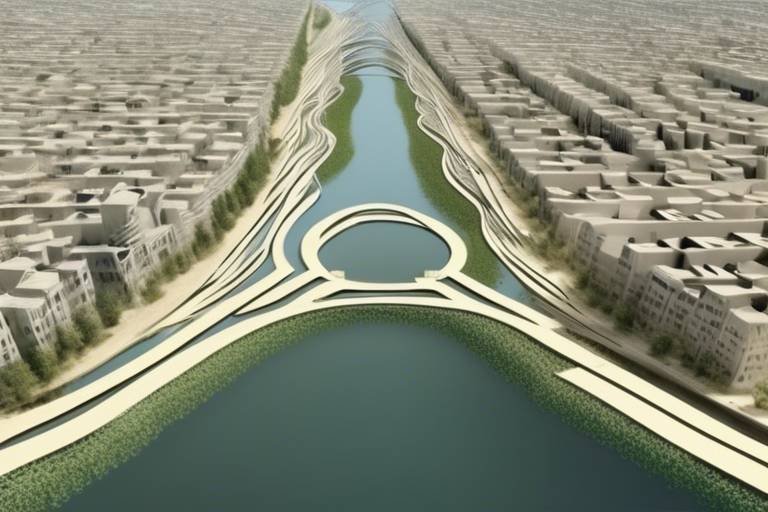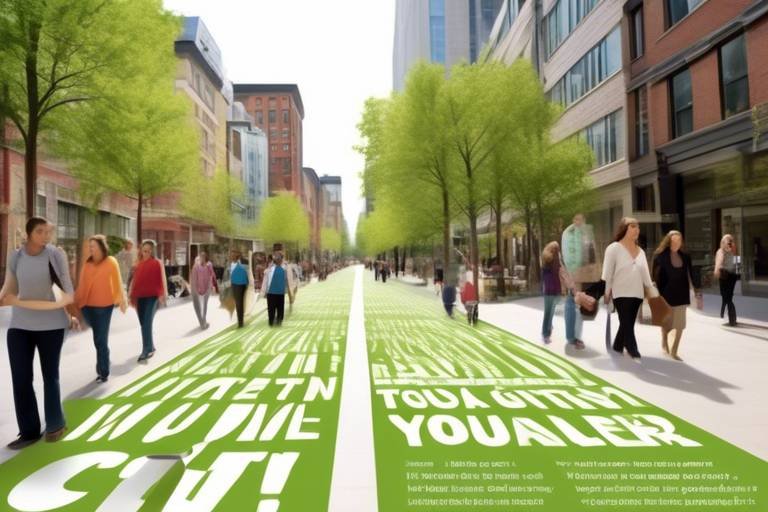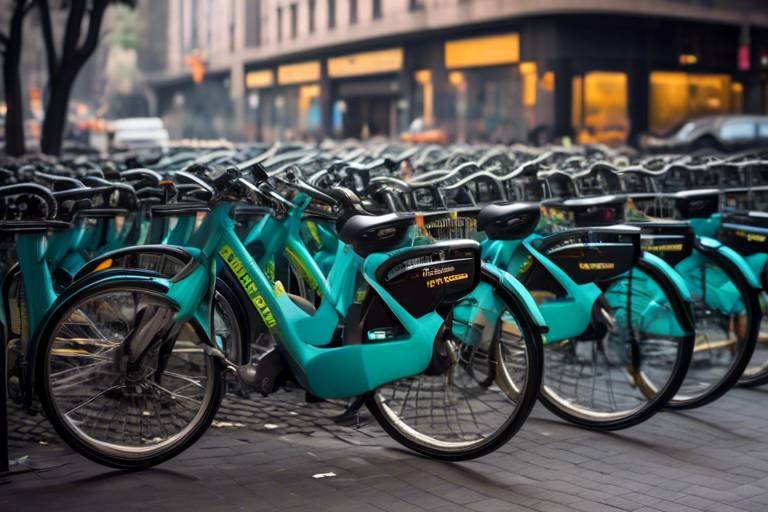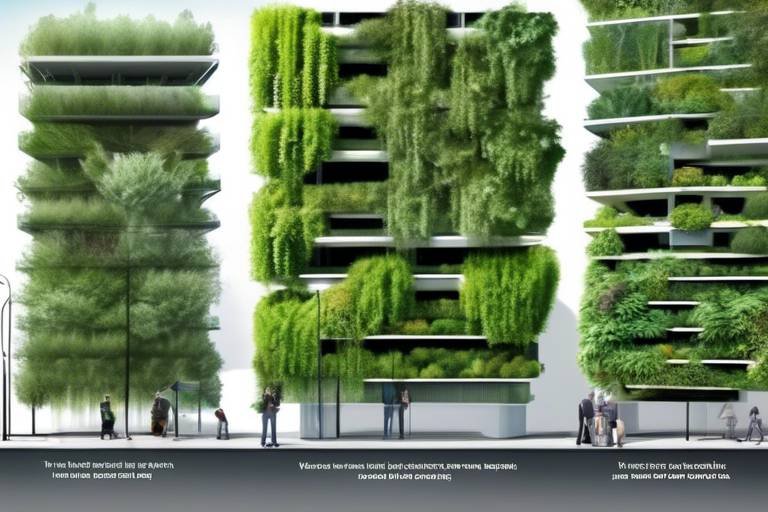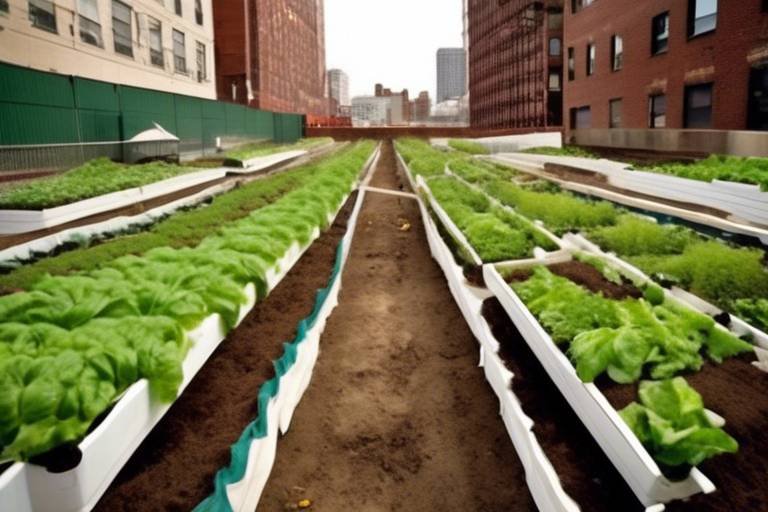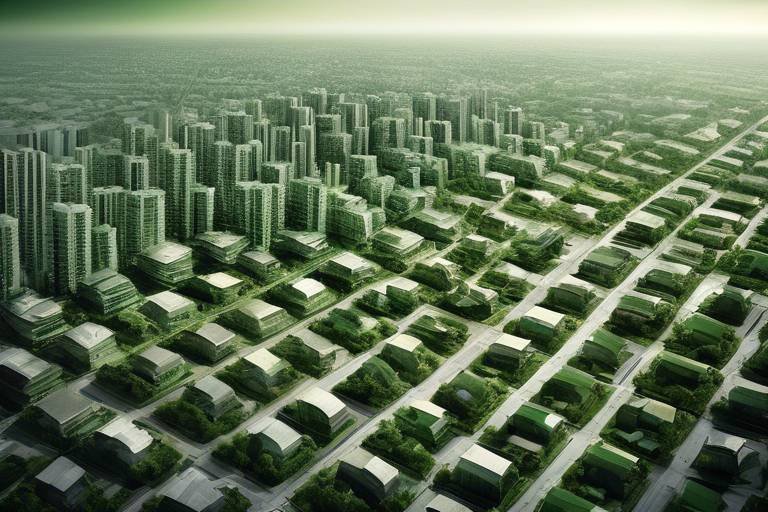The Impact of Urban Design on Water Management
Urban design is more than just aesthetics; it profoundly influences how cities manage their most precious resource: water. As urban areas continue to grow, the need for effective water management becomes increasingly critical. The design of our cities can either exacerbate or alleviate water-related challenges. For instance, consider how a well-planned city can mitigate flooding through strategic placement of green spaces and water retention systems. On the flip side, a poorly designed urban landscape can lead to severe flooding, water pollution, and even droughts. This article delves into the intricate relationship between urban design and water management practices, highlighting both the challenges faced and the innovative solutions that can enhance sustainability and resilience in urban environments.
When we think about urban design, we often envision tall buildings, bustling streets, and vibrant public spaces. However, the underlying infrastructure that supports these elements is crucial for effective water management. Urban planners and designers must consider how water flows through a city, identifying areas prone to flooding and ensuring that stormwater is effectively managed. This involves integrating water management strategies into the overall urban planning process, which can lead to more efficient use of resources and reduced risks associated with flooding.
One of the most significant impacts of urban design on water management is the concept of green infrastructure. This approach incorporates natural systems into urban environments, allowing cities to manage stormwater more effectively. For example, rain gardens and permeable pavements are innovative solutions that not only help with water management but also enhance urban biodiversity. By creating spaces where water can infiltrate the ground rather than running off into storm drains, cities can improve water quality and contribute to healthier ecosystems. Imagine walking through a neighborhood where rainwater is absorbed by lush gardens rather than rushing down the streets; this is the transformative power of thoughtful urban design.
Moreover, the benefits of rainwater harvesting systems in urban areas cannot be overstated. These systems can significantly reduce reliance on municipal water supplies, which is especially vital in regions facing water scarcity. By capturing rainwater for use in irrigation, toilet flushing, and other non-potable applications, cities can alleviate pressure on their water systems. This not only promotes sustainable water usage practices among residents and businesses but also enhances community resilience against climate-related challenges.
As we explore the various elements of urban design that impact water management, it's essential to recognize that the challenges are multifaceted. Aging infrastructure, climate change, and increasing population density all pose significant hurdles. Cities must adapt their water management strategies to address these challenges effectively. This adaptability is crucial for ensuring that urban areas can cope with the realities of a changing climate and growing populations.
In conclusion, the impact of urban design on water management is profound and far-reaching. By embracing innovative solutions and prioritizing sustainable practices, cities can create environments that not only manage water effectively but also enhance the quality of life for their residents. As we move forward, it is imperative that urban planners, policymakers, and community members work together to create resilient urban landscapes that can thrive in the face of environmental challenges.
- What is green infrastructure? Green infrastructure refers to a network of natural and semi-natural features, including parks, green roofs, and permeable pavements, designed to manage stormwater and enhance urban biodiversity.
- How does urban design affect flooding? Thoughtful urban design can minimize flooding by incorporating features that manage stormwater effectively, such as rain gardens and bioswales, which allow water to infiltrate the ground rather than overwhelming drainage systems.
- What are the benefits of rainwater harvesting? Rainwater harvesting reduces dependence on municipal water supplies, mitigates flooding, and promotes sustainable water use among residents and businesses.

The Role of Urban Planning in Water Management
Urban planning is more than just designing streets and buildings; it’s about creating a harmonious relationship between people and their environment. When we talk about water management, urban planning becomes a pivotal player. It ensures that cities not only accommodate growth but also manage their water resources efficiently. Think about it: cities are like sponges, absorbing water during rainfall. If not designed properly, they can easily become overwhelmed, leading to flooding and water pollution. Urban planners must consider natural water flows, local climate conditions, and community needs to create a sustainable water management strategy.
One of the key roles of urban planning in water management is the integration of water-sensitive design principles. This approach focuses on managing the quantity and quality of stormwater runoff, which is crucial in urban areas where impervious surfaces dominate. By incorporating features like green roofs, wetlands, and bioswales, planners can enhance the natural ability of the landscape to absorb and filter water. This not only mitigates flooding but also improves the overall health of urban ecosystems. Imagine a city where rainwater is not seen as a nuisance but as a precious resource that nourishes green spaces and replenishes groundwater.
Moreover, effective urban planning involves a comprehensive understanding of the water cycle and its interaction with urban infrastructure. For instance, planners must account for how water moves through the city, from precipitation to runoff to drainage systems. This requires a collaborative approach, involving engineers, environmental scientists, and community stakeholders. By fostering collaboration, cities can develop innovative solutions that address their unique water management challenges. For example, in cities facing severe droughts, planners might prioritize the development of water recycling facilities and rainwater harvesting systems, ensuring a resilient water supply.
Another critical aspect of urban planning is the regulatory framework that governs water management practices. Zoning laws, building codes, and environmental regulations play a significant role in shaping how water is managed in urban settings. Planners must navigate these regulations to promote sustainable practices while ensuring compliance. This often involves educating developers and the community about the importance of sustainable water management. When everyone understands the benefits—like reduced flooding, improved water quality, and enhanced community aesthetics—support for these initiatives grows.
In summary, urban planning is a fundamental component of effective water management. By integrating water-sensitive design principles, understanding the water cycle, fostering collaboration, and navigating regulatory frameworks, planners can create urban environments that are not only functional but also sustainable. The future of our cities depends on how well we manage our water resources today. So, let’s embrace innovative urban planning strategies that prioritize water management and contribute to a healthier planet.
- What is water-sensitive urban design? Water-sensitive urban design (WSUD) is an approach that integrates the management of the urban water cycle into the planning and design of urban environments.
- How can urban planning help reduce flooding? By incorporating green infrastructure and designing landscapes that absorb and manage stormwater, urban planning can significantly reduce the risk of flooding.
- What role does community engagement play in urban water management? Engaging the community ensures that water management strategies reflect the needs and values of residents, fostering support for sustainable practices.

Green Infrastructure Solutions
When it comes to urban environments, the challenges of managing stormwater and ensuring water quality can feel overwhelming. However, are stepping in to change the game. These innovative approaches not only address water management issues but also enhance the overall health of urban ecosystems. Imagine a city where rainwater is not just a nuisance but a resource that nourishes green spaces and supports biodiversity. Sounds ideal, right? Well, that's precisely what green infrastructure aims to achieve!
One of the standout features of green infrastructure is its ability to mimic natural processes. By integrating elements like rain gardens and permeable pavements into urban design, cities can effectively manage stormwater runoff. For instance, rain gardens are designed to capture and filter rainwater, allowing it to soak into the ground rather than overwhelming drainage systems. This not only reduces the risk of flooding but also enhances groundwater recharge, creating a win-win situation for both urban planners and residents.
Permeable pavements are another fantastic example of green infrastructure at work. These innovative surfaces allow rainwater to infiltrate through the pavement and into the soil below, significantly reducing runoff and preventing the dreaded urban flooding. It’s like giving the city a set of lungs, allowing it to breathe and manage water naturally. Imagine walking on a beautiful, smooth pavement that also helps to keep the streets dry during heavy rains. It’s not just functional; it’s a step toward a more sustainable and resilient urban landscape.
But the benefits of green infrastructure extend beyond just water management. They also contribute to improving urban biodiversity. By creating green spaces, cities provide habitats for various species, from birds to butterflies, which can thrive in environments that have been designed with nature in mind. This not only beautifies the city but also fosters a connection between residents and their natural surroundings. Think of it as a way to bring a slice of nature back into our increasingly concrete jungles.
Moreover, the implementation of green infrastructure can lead to significant cost savings in the long run. By reducing the need for extensive drainage systems and minimizing flood damage, cities can allocate resources more efficiently. According to a recent study, cities that invest in green infrastructure can see a return on investment of up to 300% over 20 years. That’s not just a number; it’s a testament to the long-term viability and sustainability of these practices.
In summary, green infrastructure solutions are not just a trend; they are a necessity for modern urban living. By embracing these innovative approaches, cities can enhance water management, promote biodiversity, and create a healthier environment for all residents. The question is, are we ready to embrace this green revolution and transform our urban landscapes for the better?
- What is green infrastructure? Green infrastructure refers to a network of natural and semi-natural systems that provide environmental benefits, particularly in managing stormwater and enhancing urban biodiversity.
- How do rain gardens work? Rain gardens are designed to capture rainwater runoff from impervious surfaces, allowing it to percolate into the ground, which helps filter pollutants and recharge groundwater.
- What are the benefits of permeable pavements? Permeable pavements allow rainwater to infiltrate through the surface, reducing runoff, preventing flooding, and improving water quality.
- Can green infrastructure save cities money? Yes, by reducing the need for extensive drainage systems and minimizing flood damage, cities can save significantly on infrastructure costs over time.

Benefits of Rainwater Harvesting
Rainwater harvesting is not just a trendy buzzword; it's a powerful tool that can transform urban water management. Imagine a world where every drop counts, where rainwater is captured and reused, reducing our dependence on traditional water sources. This practice is like a safety net for cities, providing numerous benefits that enhance sustainability and resilience. So, what exactly are these benefits?
First and foremost, rainwater harvesting significantly reduces reliance on municipal water supplies. In densely populated urban areas, where water demand is constantly on the rise, tapping into rainwater can alleviate pressure on local water systems. By utilizing rainwater for non-potable uses such as irrigation, toilet flushing, and even washing cars, cities can conserve precious drinking water resources.
Moreover, this method helps to mitigate flooding. When rain falls on impervious surfaces like roads and rooftops, it creates runoff that can overwhelm drainage systems. By capturing rainwater in storage tanks or cisterns, cities can control the volume of runoff, reducing the risk of urban flooding. This is particularly crucial in areas prone to heavy rainfall, where flash floods can cause significant damage and pose safety hazards.
Another aspect worth mentioning is the improvement in water quality. When rainwater is collected and properly filtered, it can be cleaner than water from traditional sources, which often undergoes extensive treatment processes. This not only benefits the end-users but also reduces the pollution load on local waterways, promoting healthier ecosystems.
Additionally, rainwater harvesting supports sustainable water usage practices. By encouraging residents and businesses to adopt these systems, cities can foster a culture of conservation. For instance, communities that implement rainwater harvesting often see a rise in environmental awareness and a greater commitment to sustainability. This can lead to a ripple effect, inspiring others to follow suit and adopt eco-friendly practices.
To illustrate the potential impact of rainwater harvesting, consider the following table, which outlines some key statistics:
| Benefit | Impact |
|---|---|
| Reduction in Municipal Water Use | Up to 50% decrease in water bills |
| Flood Mitigation | Reduces stormwater runoff by 30-50% |
| Water Quality Improvement | Less pollution in local waterways |
| Community Engagement | Increased awareness of water conservation |
In conclusion, the benefits of rainwater harvesting extend far beyond mere water savings. They encompass environmental, economic, and social dimensions, making it a vital component of any urban water management strategy. As cities continue to grapple with water scarcity and climate change challenges, embracing rainwater harvesting could be the key to unlocking a more sustainable and resilient future.
- What is rainwater harvesting? Rainwater harvesting is the collection and storage of rainwater for reuse before it reaches the ground.
- How can I implement a rainwater harvesting system? You can install a rain barrel or cistern connected to your roof's downspouts to collect rainwater.
- Is harvested rainwater safe to drink? With proper filtration and treatment, harvested rainwater can be made safe for drinking.

Designing Effective Rain Gardens
When it comes to urban water management, rain gardens stand out as a beacon of hope and innovation. These beautifully designed landscapes are not just aesthetically pleasing; they play a vital role in capturing and filtering stormwater. Imagine a garden that not only enhances your neighborhood's beauty but also helps mitigate flooding and improve water quality. Sounds like a dream, right? Well, it’s a reality that many cities are embracing.
So, what exactly goes into designing an effective rain garden? First and foremost, location is key. A well-placed rain garden should be situated where it can capture runoff from impervious surfaces like roofs, driveways, and sidewalks. This strategic positioning allows the garden to act as a natural sponge, absorbing excess water and preventing it from overwhelming drainage systems.
Next, let’s talk about the plant selection. Choosing the right plants is crucial for the success of a rain garden. Native plants are often the best choice because they are adapted to local conditions and require less maintenance. Additionally, they attract beneficial insects and wildlife, which can enhance biodiversity in urban areas. Consider incorporating a mix of grasses, perennials, and shrubs that can thrive in both wet and dry conditions. This variety ensures that the garden remains vibrant year-round, even when rainfall fluctuates.
Another important aspect is the soil composition. A well-designed rain garden should have a mix of sandy loam and organic matter to promote proper drainage while retaining moisture. This balance is essential for the plants to thrive and for the garden to effectively filter pollutants from the runoff. You wouldn't want your beautiful garden to turn into a muddy mess, right?
To give you a clearer picture, here’s a simple table outlining the key components of an effective rain garden:
| Component | Description |
|---|---|
| Location | Near impervious surfaces to capture runoff. |
| Plant Selection | Native plants that thrive in varying moisture levels. |
| Soil Composition | A mix of sandy loam and organic matter for drainage. |
| Maintenance | Regular weeding and monitoring for plant health. |
But it doesn’t stop there! Maintenance is also an essential part of keeping a rain garden effective. Regular weeding and monitoring for plant health can ensure that your rain garden continues to function as intended. Think of it as nurturing a child; with proper care and attention, it will flourish and provide benefits for years to come.
In conclusion, designing effective rain gardens is a multifaceted process that requires thoughtful planning and consideration of various elements. By strategically placing these gardens, selecting the right plants, and maintaining them properly, cities can harness the power of nature to manage stormwater effectively. So, why not get involved in your community's efforts to create these green spaces? Together, we can cultivate a more sustainable urban environment!
- What is a rain garden? A rain garden is a planted depression that allows rainwater runoff from impervious surfaces to be absorbed, promoting groundwater recharge and reducing flooding.
- How do I maintain a rain garden? Regular weeding, monitoring plant health, and ensuring proper drainage are key maintenance practices for a rain garden.
- Can I use non-native plants in my rain garden? While you can use non-native plants, it's best to choose native plants as they are better adapted to local conditions and support local wildlife.
- Are rain gardens expensive to install? The cost can vary depending on size and materials, but many communities offer resources and support to help offset costs.

Permeable Pavements in Urban Areas
Permeable pavements are a revolutionary solution in urban design that addresses the pressing issue of stormwater management. Unlike traditional impermeable surfaces, which can exacerbate flooding and runoff, permeable pavements allow rainwater to infiltrate through their surfaces and into the ground below. This process not only helps in reducing the volume of water that flows into storm drains but also promotes groundwater recharge, which is essential for maintaining the natural water cycle in urban environments.
One of the most significant advantages of permeable pavements is their ability to mitigate the urban heat island effect. Traditional concrete and asphalt surfaces absorb and retain heat, leading to higher temperatures in urban areas. However, permeable pavements can help cool the surrounding environment by allowing water to evaporate from the surface, thus lowering ambient temperatures. This cooling effect can be a game-changer for cities struggling with rising temperatures, especially during the summer months.
Moreover, permeable pavements can enhance water quality. As rainwater passes through these surfaces, it is naturally filtered, reducing pollutants and contaminants before they reach the groundwater. This filtration process is crucial in urban areas where runoff often carries oils, heavy metals, and other harmful substances from roads and parking lots. By implementing permeable pavements, cities can significantly improve the quality of their water resources.
In addition to their environmental benefits, permeable pavements can also be aesthetically pleasing. They come in various materials, including porous asphalt, permeable concrete, and interlocking pavers, allowing urban planners to choose options that complement the overall design of the area. This versatility means that permeable pavements can be integrated into parks, walkways, and even driveways, enhancing the visual appeal of urban spaces while serving a functional purpose.
However, it’s essential to recognize that the implementation of permeable pavements is not without its challenges. Proper installation and maintenance are critical to ensure their effectiveness. If not maintained, these surfaces can become clogged with debris, reducing their permeability and defeating their purpose. Therefore, cities must invest in regular upkeep and educate the community about the importance of keeping these surfaces clean.
To illustrate the impact of permeable pavements, consider the following table that summarizes their benefits compared to traditional pavements:
| Feature | Permeable Pavements | Traditional Pavements |
|---|---|---|
| Stormwater Management | Reduces runoff and promotes infiltration | Increases runoff and flood risk |
| Water Quality | Filters pollutants before reaching groundwater | Allows contaminants to flow directly into drains |
| Urban Heat Island Effect | Helps cool the environment | Increases heat retention |
| Aesthetic Appeal | Variety of designs available | Often plain and uninviting |
In conclusion, permeable pavements represent a sustainable and innovative approach to urban water management. By allowing rainwater to infiltrate and recharge groundwater, they not only help mitigate flooding but also enhance the overall quality of urban life. As cities continue to grow and face the challenges of climate change, the adoption of permeable pavements may prove to be a vital component in creating resilient urban environments.
- What are permeable pavements made of? Permeable pavements can be made from various materials, including porous asphalt, permeable concrete, and interlocking pavers.
- How do permeable pavements improve water quality? They filter pollutants from rainwater as it passes through the surface, preventing contaminants from reaching groundwater.
- Do permeable pavements require maintenance? Yes, regular maintenance is necessary to prevent clogging and ensure their effectiveness.
- Can permeable pavements be used in all climates? While they are effective in many climates, their performance may vary based on local weather conditions and soil types.

Case Studies of Successful Urban Water Management
When we dive into the world of urban water management, it’s fascinating to see how different cities have tackled their unique challenges with innovative solutions. Take, for example, the city of Melbourne, Australia. Faced with increasing urbanization and the risk of flooding, Melbourne implemented a comprehensive Integrated Water Management (IWM) approach. This strategy not only focused on stormwater management but also integrated water supply and wastewater management, showcasing a holistic view of urban water systems. By incorporating green infrastructure, such as rain gardens and green roofs, Melbourne has significantly reduced runoff and improved water quality in its waterways.
Another inspiring case is Singapore, which has transformed its water management landscape through the ABC Waters Program. This initiative focuses on creating a sustainable water environment by integrating water management into the urban landscape. The program emphasizes the importance of public spaces that double as water management solutions. For instance, the Marina Barrage not only serves as a dam to control flooding but also creates a recreational space for the community. It’s a perfect example of how urban design can marry functionality with aesthetics.
In the United States, the city of Philadelphia has made waves with its Green City, Clean Waters program. This initiative aims to manage stormwater through green infrastructure, targeting a 85% reduction in combined sewer overflows by 2036. The city has implemented permeable pavements, green roofs, and rain gardens throughout its neighborhoods. These efforts not only help manage stormwater but also enhance urban biodiversity and create vibrant community spaces. The project has proven that investing in green infrastructure can yield significant environmental and social benefits.
To further illustrate the effectiveness of these initiatives, consider the following table that summarizes the key features of these successful urban water management case studies:
| City | Key Initiative | Impact |
|---|---|---|
| Melbourne | Integrated Water Management | Reduced runoff and improved water quality |
| Singapore | ABC Waters Program | Integrated water management with public spaces |
| Philadelphia | Green City, Clean Waters | 85% reduction in combined sewer overflows |
These case studies not only highlight successful strategies but also demonstrate the importance of community involvement and innovative thinking in urban water management. Each city faced its own set of challenges, yet they found unique solutions that not only addressed immediate concerns but also paved the way for a more sustainable future. By learning from these examples, other cities can adopt similar practices tailored to their specific needs, ultimately leading to a more resilient urban environment.
- What is urban water management?
Urban water management refers to the planning and implementation of strategies to manage water resources in urban areas effectively. This includes stormwater management, water supply, and wastewater treatment. - How does green infrastructure help in water management?
Green infrastructure uses natural processes to manage stormwater, reduce runoff, and improve water quality. Examples include rain gardens, green roofs, and permeable pavements. - Why is community engagement important in urban water management?
Engaging the community fosters support for initiatives, encourages sustainable practices, and ensures that water management strategies reflect the needs and values of the residents.

Challenges in Urban Water Management
Urban water management is a complex puzzle, and unfortunately, many cities are struggling to fit the pieces together. One of the biggest challenges is the aging infrastructure that many urban areas rely on. Pipes burst, treatment plants become overwhelmed, and drainage systems fail to keep up with heavy rainfalls. This not only leads to flooding but also compromises the quality of water supplied to homes and businesses. Imagine your morning routine disrupted by a sudden water outage or worse, contaminated water pouring from your tap—it's a nightmare scenario that many urban residents face.
Climate change is another formidable opponent in the realm of urban water management. As global temperatures rise, cities are experiencing more extreme weather events, including torrential downpours and prolonged droughts. This erratic weather pattern complicates water resource planning and management. For instance, during a heavy rainstorm, urban areas can quickly become inundated, leading to flash floods that put lives at risk and cause significant property damage. On the flip side, during a drought, the demand for water skyrockets, leaving cities scrambling to find sustainable sources. The unpredictability of climate change necessitates that urban planners adopt a more flexible and adaptive approach to water management.
Moreover, increasing population density in urban areas exacerbates these challenges. More people mean greater water demand, which can strain existing water supplies and infrastructure. Urban sprawl often leads to the development of impermeable surfaces like concrete and asphalt, which prevent rainwater from soaking into the ground. This results in increased runoff, which can overwhelm drainage systems and lead to flooding. According to a recent study, cities with higher population densities experience 30% more runoff compared to less populated areas. It’s a vicious cycle that requires innovative solutions and proactive planning.
Another significant challenge is public engagement and awareness. Many residents are unaware of the importance of sustainable water practices or the impact of their actions on urban water systems. This lack of understanding can hinder community support for necessary infrastructure improvements and sustainable initiatives. To combat this, cities need to prioritize education and outreach programs that inform residents about their role in water conservation and management. After all, if the community doesn’t understand the stakes, how can they be expected to contribute to solutions?
In summary, the challenges facing urban water management are multifaceted and interrelated. From aging infrastructure and the impacts of climate change to increasing population density and the need for public engagement, cities must navigate a complex landscape. However, addressing these challenges head-on with innovative solutions and community involvement can lead to a more sustainable and resilient urban future.
- What are the main challenges in urban water management? The main challenges include aging infrastructure, climate change impacts, increasing population density, and the need for public engagement.
- How does climate change affect urban water systems? Climate change leads to extreme weather events, altered precipitation patterns, and increased water demand, complicating water management efforts.
- Why is public engagement important in urban water management? Engaging the public fosters community support, promotes sustainable practices, and ensures that urban design reflects the needs and values of residents.

Climate Change and Its Effects
Climate change is not just a distant threat; it is a reality that urban areas are grappling with today. The effects of climate change on urban water management are profound and multifaceted. As temperatures rise and weather patterns become increasingly erratic, cities face challenges that threaten their water systems. For instance, extreme weather events, such as heavy rainfall and prolonged droughts, can overwhelm existing infrastructure and disrupt the delicate balance of urban ecosystems.
One of the most significant impacts of climate change is the alteration of precipitation patterns. In many regions, rainfall has become more intense and sporadic, leading to flash floods that can wreak havoc on drainage systems. Conversely, other areas experience longer dry spells, which can strain water supplies and increase competition for this precious resource. This duality creates a pressing need for cities to rethink their water management strategies.
Additionally, rising sea levels pose a serious threat to coastal cities, increasing the risk of saltwater intrusion into freshwater supplies. As urban populations continue to grow, the demand for clean water escalates, further complicating the situation. Cities must adapt to these changes by investing in resilient infrastructure and sustainable practices that can withstand the unpredictable nature of climate impacts.
The consequences of climate change extend beyond just physical infrastructure; they also have social and economic implications. Vulnerable communities often bear the brunt of these changes, facing higher risks of flooding and water scarcity. Engaging these communities in water management discussions is crucial. It fosters a sense of ownership and ensures that solutions are equitable and effective.
To illustrate the urgency of these issues, consider the following table that summarizes key climate change effects on urban water management:
| Climate Change Effect | Impact on Water Management |
|---|---|
| Altered Precipitation Patterns | Increased flooding and drought conditions |
| Rising Sea Levels | Saltwater intrusion into freshwater sources |
| Extreme Weather Events | Overwhelming of drainage systems |
| Increased Water Demand | Strain on already limited water supplies |
In conclusion, the effects of climate change on urban water management are complex and require a multifaceted response. Cities must embrace innovative solutions, such as green infrastructure and community engagement, to adapt to these challenges. By doing so, they can create resilient water management systems that not only protect against climate impacts but also promote sustainability and equity for all residents.
- What are the main effects of climate change on urban water systems?
The main effects include altered precipitation patterns, increased flooding, prolonged droughts, and rising sea levels, all of which challenge existing water management infrastructure.
- How can cities adapt to climate change?
Cities can adapt by implementing green infrastructure solutions, improving drainage systems, and engaging communities in water management practices.
- Why is public engagement important in water management?
Public engagement fosters community support, ensures that solutions reflect the needs of residents, and promotes sustainable practices among citizens.

Public Engagement and Awareness
Public engagement and awareness are pivotal in shaping effective water management strategies within urban environments. When residents understand the significance of sustainable practices, they become active participants in the solution rather than passive observers. This shift in perspective not only empowers individuals but also fosters a sense of community responsibility towards local water resources. Imagine a neighborhood where every household collects rainwater and uses it for gardening or washing cars; that’s not just a dream, but a reality that can be achieved through awareness and engagement.
One of the most effective ways to boost public awareness is through educational programs and community workshops. These initiatives can elucidate the importance of water conservation and the role of urban design in managing water resources. For instance, local governments can organize events that teach residents how to create their own rain gardens or install rain barrels. Such hands-on experiences not only increase knowledge but also build a community of like-minded individuals who can support each other in their sustainability efforts.
Moreover, leveraging technology can significantly enhance public engagement. Social media platforms, mobile apps, and websites can be utilized to disseminate information about water management practices, upcoming community events, and local regulations. For example, a city might use an app to notify residents about stormwater management tips or to report issues like flooding or drainage problems. This two-way communication fosters a proactive approach to urban water management.
To further enhance community involvement, cities can establish partnerships with local organizations and schools. By integrating water management education into school curricula, students can learn about the water cycle, conservation techniques, and the impact of urban design on water resources. This not only informs the younger generation but also encourages them to bring these lessons home, influencing their families’ behaviors.
In addition, creating platforms for community feedback is essential. Cities should actively seek input from residents regarding water management policies and urban design projects. This can be achieved through town hall meetings, surveys, and online forums. When people feel their voices are heard, they are more likely to support and participate in initiatives that aim to improve their environment.
Ultimately, the goal of public engagement in water management is to cultivate a culture of sustainability. By fostering awareness and encouraging participation, urban areas can develop resilient water management systems that not only address current challenges but also prepare for future uncertainties. Remember, every drop counts, and when communities unite for a common cause, the impact can be monumental.
Q1: Why is public engagement important in water management?
A1: Public engagement is crucial because it empowers residents to take part in sustainable practices, fosters community responsibility, and enhances the effectiveness of water management strategies.
Q2: How can I get involved in my community's water management initiatives?
A2: You can participate by attending local workshops, joining community groups focused on sustainability, and advocating for policies that promote responsible water use.
Q3: What role does technology play in public engagement for water management?
A3: Technology facilitates communication and information sharing, making it easier for residents to learn about water management practices and engage with local initiatives through apps and social media.
Q4: How can schools contribute to water management awareness?
A4: Schools can incorporate water management topics into their curricula, organize field trips to local water facilities, and encourage students to participate in community projects related to water conservation.
Frequently Asked Questions
- How does urban design influence water management?
Urban design plays a pivotal role in shaping how cities manage water resources. By integrating water management strategies into urban planning, cities can minimize flood risks, enhance resource efficiency, and promote sustainable development. It's like creating a well-oiled machine where every part works together to ensure smooth operations!
- What are green infrastructure solutions?
Green infrastructure solutions, such as rain gardens and permeable pavements, are innovative ways to manage stormwater naturally. They not only improve water quality but also boost urban biodiversity. Think of them as the city's lungs, helping to filter and clean the air while managing water effectively!
- What are the benefits of rainwater harvesting?
Implementing rainwater harvesting systems can significantly reduce reliance on municipal water supplies. They help mitigate flooding and encourage sustainable water usage among residents and businesses. It's like having your own little reservoir at home, ready to serve when needed!
- How can rain gardens be designed effectively?
Effective rain gardens are strategically designed to capture and filter stormwater. They provide functional benefits by promoting groundwater recharge while also enhancing the aesthetic appeal of urban landscapes. Imagine a beautiful garden that not only looks good but also plays a crucial role in managing water!
- What challenges do urban areas face in water management?
Urban areas encounter numerous challenges in water management, including aging infrastructure, the impacts of climate change, and increasing population density. These factors necessitate adaptive strategies to ensure sustainable solutions. It's like navigating a maze where each turn presents new obstacles to overcome!
- How does climate change affect urban water systems?
Climate change leads to extreme weather events and altered precipitation patterns, putting a strain on urban water systems. As demand for water increases, cities must adapt their management approaches to cope with these changes. Think of it as a rollercoaster ride, where you have to brace yourself for unexpected twists and turns!
- Why is public engagement important in water management?
Engaging the public in water management initiatives is crucial for fostering community support and promoting sustainable practices. When residents feel involved, urban design can better reflect their needs and values. It's like a team sport where everyone plays a role in achieving a common goal!

